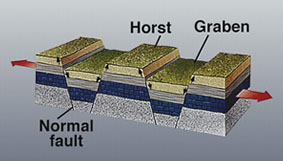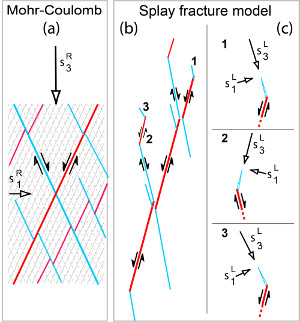| |||||||
|
|
|||||||
|
|
|||||||
| Conjugate Faults | |||||||
|
The term conjugate faults refers to a configuration of two sets of faults with opposite sense of shearing. They generate horsts (uplifted blocks) and grabens (depressed blocks) as illustrated schematically in a diagram in Figure 1. There are two types of conjugate fault patterns depending on their formation mechanisms. The first one is also known as the Anderson's model in which conjugate faults form as shear fractures under a single static remote stress field as illustrated in Figure 2(a). The angle between the two sets depends on the friction coefficient across the faults, which is commonly 0.6 corresponding to a friction angle of 30 degrees. In this case, the largest compressive or the least tensile principle stress bisects the acute intersection angle between two sets and the intermediate principal stress lies along the intersection line of the two sets. An alternative mechanism of formation of conjugate faults is shearing of an initial discontinuity, splay fracturing, and sequential shearing of the splays (Figures 2(b) and (c)). To distinguish this from the former, this is referred to as apparent conjugate configuration which is different than the former in terms of the mechanisms and the resulting geometry (Davatzes, 2003). | |||||||
| Reference: |
|||||||
| Davatzes, N.C., 2003 |
|||||||
|
Readme | About Us | Acknowledgement | How to Cite | Terms of Use | Ⓒ Rock Fracture Knowledgebase |
|||||||

